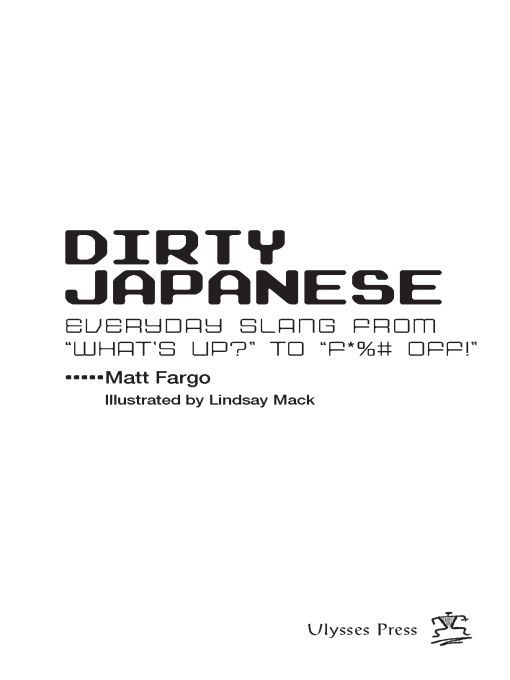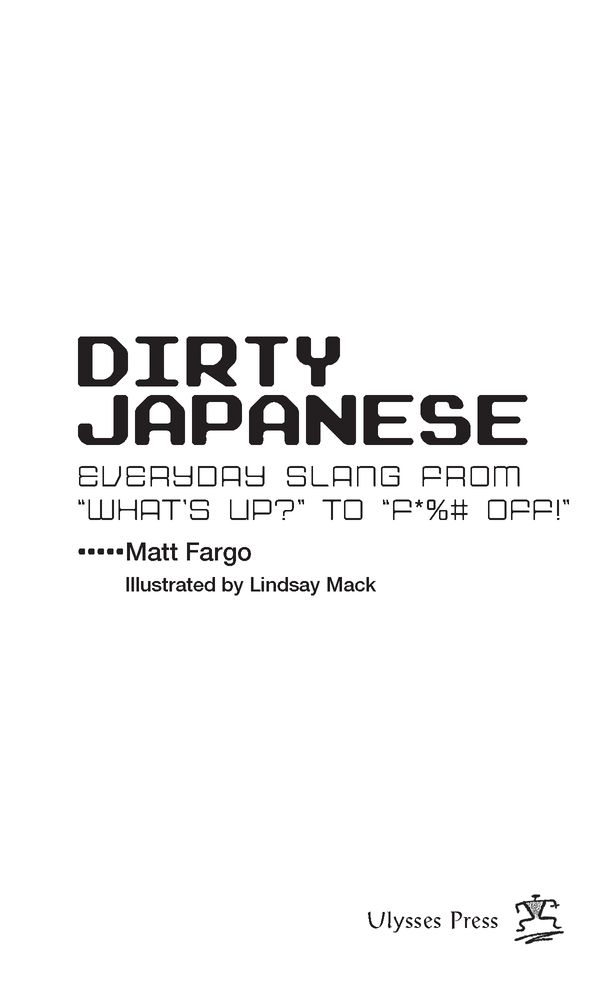Matt Fargo
Authors: Dirty Japanese: Everyday Slang From "What's Up?" to "F*%# Off!"


Table of Contents


Soli Tansman Gloria
Acknowlegments
I’d like to thank Professor Alan Tansman for being as generous as he is wise, Charlie Emrich, Matthew Suidan, Tami Downes and Brooke Ray Smith for putting up with ridiculous questions about human anatomy, Alice for teaching me to love again, Nakayama Risa for advice about anime and manga, Seigo Nakao for his sagacious vetting, Oooka Hironori for being absurdly handsome, Ito Gabin for blowing my mind, Zach Anderson and Aaron Cavin for their cylindrical beards, all the people at Ulysses Press for tolerating my dirty mouth, and of course Kameko for her ineffable shell. I love you all.
USING THIS BOOK
I wrote this book assuming that you already know at least enough Japanese to get by. Maybe you’ve spent enough time in Japan to get the hang of the basics. Or maybe you nerded out on so much anime that you acquired the entire Gundam vocabulary through osmosis. Or listened to those “Learn Japanese in 24 Hours” CDs until you can order blowfish sashimi without batting an eyelid. Whatever, this book is designed to expand your Japanese past the edge of conventional learning methods.
One thing about the Japanese language, which you’ll find me repeating all through this book—it’s very, very contextual. What you say depends on who you are speaking to, and this book is meant to be used in the company of friends. So be warned that if you say any of the words and phrases in Dirty Japanese to someone older than you, or to a stranger of any age, you can expect them to look at you as if you’d just peed in their kitchen sink.
But when you’re among friends or fellow debauchers, let’s face it—“Konnichiwa, yoroshiku onegai shimasu” is going to make you stand out like… well… a foreigner.
So Dirty Japanese is all about the up-to-date slangish words, super-casual phrases, sexy sayings, and innuendos
that you aren’t going to find anywhere else. (And yes, there’s some just plain rude, deficky stuff too. Fuck it—readers with delicate sensibilities can skip over those pages and still get plenty of benefit from the rest of the book.)
that you aren’t going to find anywhere else. (And yes, there’s some just plain rude, deficky stuff too. Fuck it—readers with delicate sensibilities can skip over those pages and still get plenty of benefit from the rest of the book.)
Each word or phrase in English is followed by its Japanese equivalent, first as it’s written in Japanese characters and then spelled out in the Roman alphabet. A lot of people
who speak pretty decent Japanese can’t read a word of it—and you don’t really need to. Well, not unless you hope to find your way around Tokyo on your own. You can still get everything in this book from the Roman alphabet versions.
〈〈〈〈READING JAPANESE〉〉〉〉
If you haven’t tackled the challenge of learning to read Japanese yet, it’s not as hard as it looks like it should be. Japanese writing uses three (or maybe four) different sets of characters.
HIRAGANA, full of loops and curves, is an “alphabet” made up of 46 characters representing every sound in the Japanese language—a, i, u, e, o, ka, ki, ku, ke, ko, sa, shi, su, se, so, ta, chi, tsu . . . and so on. It is usually used for writing basic Japanese words. The following words are written in hiragana:
 | ossu | What’s up! |
 | ampontan | dorkface |
 | isoginchaku | sea anemone |
KATAKANA, a simple, angular “alphabet,” also has 46 characters. Each one corresponds to a hiragana character, though there can be subtle differences in pronunciation that you don’t really need to worry about. It is usually used for writing borrowed foreign words (like “computer”), foreign names, company names, and newly coined Japanese words (like “karaoke”). Here are some examples of katakana:
 | baiagura | Viagra |
 | tomu kurūzu | Tom Cruise |
 | rāmen | ramen |
Other books
Mariel by Jo Ann Ferguson
Into My Arms by Lia Riley
Knot (Road Kill MC #2) by Marata Eros
Disney by Rees Quinn
What the Single Dad Wants... by Marie Ferrarella
Are You There, Vodka? It's Me, Chelsea by Chelsea Handler
Agent Storm: My Life Inside al-Qaeda by Morten Storm, Paul Cruickshank, Tim Lister
Evidence of the Afterlife: The Science of Near-Death Experiences by Long, Jeffrey, Perry, Paul
Inseparable by Brenda Jackson
The Sempster's Tale by Margaret Frazer
